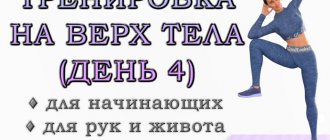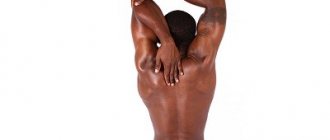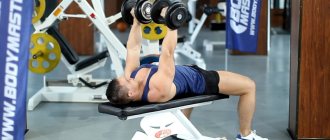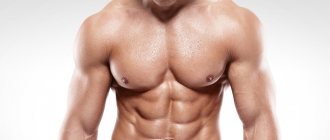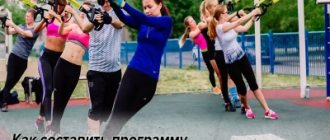Why is it effective to train your chest and shoulders on the same day?
If the thought of combining shoulders and chest in one workout doesn't shock you, it's time to move on to the benefits of such a split. It is important to understand that despite the popular combinations, which are based on the development of antagonist muscles, this split uses a completely different principle. Work on each group is based on the stress consolidation method, where similar muscle groups are intelligently combined.
There are two main types of splits for training the shoulders and chest. The first is based on working out the chest, as well as the front deltoids, which will already receive a load in the pressing movements, in one workout. In most cases, exercises for the middle deltoids are added to this training. In this case, the posterior head will be worked out on back day, which also relates to the principle of stress consolidation.
The second option is simpler - you simply train the muscle groups of the pectoral and shoulder muscles in one workout, including all three deltoids. In this case, exercises for the pectoral muscles are done first, and the shoulders are achieved in the second half of the workout.
What benefits can this split provide? Among the main advantages are:
- The ability to focus on large muscle groups (by including shoulders on other days);
- Increasing the effectiveness of training and progression through proper shoulder training;
- Reducing the total time for shoulder training without loss of efficiency (to properly work out the deltoids, it is enough to complete 3-4 exercises);
- Reduced risk of injury due to shoulder training in static-dynamic mode.
The last point is especially worth highlighting. The practice and experience of professional athletes show that static-dynamic training for deltoids is superior to classical training in all respects. Moreover, it is incredibly relevant in such splits, where you can perform powerful basic exercises for the main muscle group (in this case, the pectorals), and work out the deltoids in a static-dynamic mode.
Exercises with dumbbells for the chest
Pressing movements are basic exercises for the chest. By pumping our backs, we pulled the apparatus towards ourselves; here, on the contrary, we will move the dumbbells away from ourselves.
Dumbbell chest press
Another effective basic exercise. The main load falls on the inner part of the muscles, the upper and lower chest are also involved.
- Lie down on a bench or, in extreme cases, on the floor, spread your arms to the sides.
- Take a deep breath and press the dumbbells up. Straighten your arms at the top point.
- Exhale and smoothly return your hands to the starting position.
Pullover
Dumbbell pullover is an exercise that works the chest and back muscles well.
- Lie down on a bench, bend your knees and arch your back as much as possible. Take a dumbbell in your hands and turn your elbows to the sides.
- Take a deep breath and lower the projectile behind your head. Pause at the bottom and stretch your muscles as much as possible.
- Return to the starting position.
Lying dumbbell flyes
This exercise is also called the “butterfly”. It develops muscles well and works out the relief.
- Lie down on a bench, place your feet shoulder-width apart and place them on the floor.
- Take dumbbells and lift them above your chest. Turn your palms towards each other, bend your arms slightly at the elbows.
- Spread your arms out to the sides so that your elbows and shoulders are in line.
- Curl the dumbbells over your chest, squeezing your chest muscles.
Recommendations from professionals for creating a program
Amateurs should not always listen to the advice of pros, because they have a completely different attitude towards training, nutrition and the general approach to progression. However, in some cases, only the advice of experienced athletes who already have impressive volumes can be most useful. We have analyzed and collected the main recommendations from world-famous athletes who have proven in practice that they understand how to do shoulders.
Tip #1 – Use Statodynamics
Many athletes of different levels have become convinced that the static-dynamic mode is ideal for the shoulders. Firstly, such training ensures muscle growth even when you have reached a plateau and have not seen progression for years. For beginners, stato-dynamics will also provide many advantages and will protect you from injuries that can occur when working with heavy weights.
Tip No. 2 - the correct ratio of exercises and cycles
It is important to understand that despite the dominance of static-dynamic training, the classics have not been canceled. Any muscle needs a variety of loads to develop, so use different cycles. If you use compound shoulder exercises, do them at the end of your chest workout. After this, give the muscles a little rest and begin to carefully work out the deltas. To do this, it will be enough to perform one exercise at a time. The only exception is the rear delta. if you train all the heads in one day, combining them with the chest, then you can add +1 exercise for the back bun.
Tip #3 – choose the most effective exercises
Stato-dynamics has become a real discovery in fitness. But despite the fact that this technique is ideal for working out the deltoids, it is extremely important to choose the right exercises. For the chest muscles, it is best to use the classics: bench press and dumbbell bench press, incline bench press, dumbbell flyes, pullover, crossover work. For the shoulders - swings in front of you, to the sides, bent over raises, bench presses in the machine, and seated delt raises in the machine.
Tip #4 – don’t chase the scales
Forget about trying your best to increase the weight of the weights when training your shoulders. Firstly, the static-dynamic mode does not require much weight; rather, on the contrary, only slight weighting will allow you to correctly reveal the essence of this technique. Secondly, you should not overload the shoulder joint with heavy weights, therefore, when combining shoulder training with the chest, it is better to give preference to high-quality training with weights of no more than 35-40% of the maximum.
In general, the main thing is to approach the matter correctly, not to perform a large number of exercises for deltas and to focus on the highest quality work on each beam. And of course, it is important to remember that the shoulders need to be trained only in partial amplitude.
Best Shoulder Exercises for the Middle Deltoids
If there are no lagging parts of the deltoid muscles, then training should begin with general exercises aimed at the middle section of the deltas.
Bench press
This exercise develops the middle and anterior deltoids. It can be performed standing or sitting, with a barbell, or in a Smith machine. The technology is identical in all versions. In my opinion, this exercise is best performed in a Smith machine to reduce injuries associated with shoulder eversion. First, light weight should be used when performing this exercise. Secondly, the exercise is not recommended for beginners.
- So, starting position: the bar is located behind the head at the level of the back of the head, the back is straight. Hands are positioned on the bar wider than shoulders, elbows pointing down.
- The upward movement begins as you exhale. At the top point, you cannot straighten your arms at the elbows completely.
- As you inhale, the bar lowers as smoothly and slowly as possible. Under no circumstances should you lower the bar suddenly.
Read more about the barbell overhead press →
Vertical press with dumbbells
A basic exercise that provides load on all parts of the deltas. Performed standing or sitting.
- Starting position: arms with dumbbells are located at the sides and bent at the elbow joints at a right angle. The back is straight.
- The upward movement begins as you exhale. The highest point of the amplitude will be reached when the dumbbells are aligned overhead. Elbows cannot be fully straightened.
- The downward movement should be performed as slowly as possible. At the lowest point of the amplitude, the dumbbells should be at shoulder level without touching the joints.
Read more about the seated dumbbell press →
Smith machine vertical press
Something between a military press and a dumbbell press. Performed at an angle of approximately 75-80 degrees.
- Starting position: at the lowest point of the amplitude, the bar is located on the upper chest, but does not touch it.
- The movement of the bar occurs over the upper part of the pectoral muscle strictly vertically as you exhale. The grip is straight, the hands are positioned wider than the shoulders.
- The downward movement should be done while inhaling as slowly as possible without a pause at the bottom point.
- If there are no shoulder injuries, it is important to perform the exercise with heavy weight.
Barbell row to the chin
This exercise uses the central part of the deltoids, and also includes the anterior bundle of muscles. It can be performed with a barbell or in a Smith machine.
- You need to take the bar with an overhand grip in the center at a distance of two thumbs between your hands.
- As you exhale, straining your shoulders, you need to pull the barbell towards your chin without touching it.
- During the upward movement, the elbows bend and move to the sides. At the top point of the amplitude, the elbow joints should be located above the shoulders.
- The return movement performed while inhaling should be smooth and slow.
Read more about barbell rows →
Raising your arms to the sides in the simulator
Working in a block simulator aimed at strengthening the deltoid muscles develops all parts. The main task is to correctly configure the simulator for anthropometric data and select the optimal weight. The exercise is best performed last in a block to develop the middle part of the deltas.
- The correct position is achieved when the rollers are located at the level of the elbow joints, or more precisely, just above the elbow joints. The back should be strictly vertical and the shoulders should be straightened.
- The upward movement is performed in a concentrated manner, tensing the deltoid muscles as you exhale. At the top point of the amplitude, the elbows should rise slightly above the horizontal position.
- At the top you need to take a short pause, and then smoothly return to the starting position while inhaling.
Swing to the side in the delta machine →
Swings with dumbbells to the sides
This exercise is aimed at developing the central part of the deltoid muscles. Performed standing or sitting.
- By clasping the dumbbells below on outstretched, slightly bent arms, exhale and perform a sideways movement.
- The arms at the elbow joints remain bent at the elbows while lifting the dumbbells. At the top point of the amplitude, the elbows should be higher than the dumbbells.
- As you inhale, the dumbbells slowly lower down and close, as in the starting position.
- It is impossible to sway and assist movement with additional muscles/
Read more about arm swings with dumbbells to the side →
Training program
It's time to move from theory to practice, so it's important to shed some light on what a chest and shoulder combination training program should look like. It is important to understand that you should not focus on just one scheme. Try to make changes, do different exercises, for example, alternating dumbbell presses and presses on the middle beam machine, or bent over swings and flyes on the rear beam machine. Remember that the combination of classics and static-dynamics is only a training model. All other principles, such as variety, progression of load, remain undeniable.
It is important to monitor the intensity and volume of your workout. The timing of your workout is important, so try to keep your workout to no more than one hour. This will be enough to fully complete all the necessary “base” for the chest and work out the shoulders in static dynamics. Fortunately, this mode of operation allows you to do approaches quite quickly.
For newbies
Even for beginner athletes, training the chest and shoulders will have its benefits, although the volume of work must be carefully monitored to avoid overtraining. Let's look at two program options that beginners can use as a basis.
Chest, anterior and middle delta:
This option includes a workout where the middle and anterior deltoid muscles are worked with the chest, and the rear group is worked on a separate day with the back muscles. The workout itself will look like this:
- Bench press;
- Incline dumbbell press;
- Lying dumbbell flyes;
- Pullover with dumbbell;
- Swing with dumbbells in front of you;
- Seated dumbbell press.
Now let's look at an example of a workout where you need to perform exercises on the posterior bundle. The program also contains one basic movement for the shoulders.
- Bench press;
- Incline dumbbell press;
- Raising arms in the simulator;
- Pullover with dumbbell;
- Army press;
- Bent-over dumbbell raises;
- Shoulder press in the simulator;
- Lifting a dumbbell in front of you.
It is important to start your shoulders with a basic exercise, then first work the back bunch, and then the middle one. This split is most effective because you do shoulder exercises on one day, leaving other days to work other muscles. It is important to remember that the anterior deltoid, which is used in most presses, is best done at the very end of the workout.
For advanced
In advanced athlete programs, the main difference will be in the volume of training and the number of sets for each exercise. Let's look at two examples of programs of professional and experienced athletes, which vary between medium and heavy deltoids.
The first version of the program involves working out all the delta bundles after the chest muscles. This allows you to reserve other training days for your back, legs and arms, giving all muscle groups an even load.
- Bench press – 4*12, 10, 8, 6;
- Hammer press/incline dumbbell press (for upper pecs) – 4*12, 10, 8, 6;
- Lying dumbbell flyes – 4*12, 10, 8, 9;
- Pullover with dumbbell – 4*12, 10, 8, 6;
- Crossover – 4*12, 12, 10, 8;
- Behind the head barbell press in Smith;
- Machine press/seated dumbbell press;
- Raising the arms for the rear delts with the chest resting on the bench;
- Lifting a dumbbell in front of you while sitting on a bench.
Chest training is performed in the standard mode, shoulders - in static-dynamic mode, in the mode of 40-45 seconds of load at a slow pace and 35-45 seconds of rest for 1 cycle. For each exercise there are 4 cycles. It is important to remember that the deltoid shoulders are usually involved in chest exercises, so only one exercise will be enough for the front beam.
The second training option involves combining only exercises for the anterior bundle with chest training. In this case, the middle and rear deltoids will be worked on back day.
- Bench press/incline – 4*12, 10, 8, 6;
- Dumbbell bench press/incline – 4*12, 10, 8, 6;
- Lying dumbbell flyes – 4*12, 10, 8, 9;
- Pullover with dumbbell – 4*12, 10, 8, 6;
- Crossover – 4*12, 12, 10, 8;
- Lifting dumbbells in front of you in a sitting position;
- Lifting the barbell in front of you while sitting;
Both shoulder exercises are performed with partial range of motion.
Basic exercises for training
Although these exercises are very dangerous for the shoulder joint, they are also very effective for gaining overall mass and strength in the shoulder muscles. We are talking about the barbell or dumbbell press in a standing or sitting position, the barbell press in the Smith machine, and the barbell row to the chin (shoulder pull). Without these exercises you will not see huge and strong deltoids. All that remains is to find out how to use them correctly so that the risk of injury is minimized and the result is maximized.
Bench press standing or seated
Let's start with a classic basic exercise for the shoulder muscles. It actively engages all three bundles of deltoid muscles, with an emphasis on the middle part. When changing the position of the elbows and a direct grip to a reverse one, the emphasis will shift to the front deltoids, but this is of little interest to us, since they already actively work in all pressing exercises. Presses can be performed both from the chest and from behind the head. The second option is very dangerous.
You need to open the delta training with presses. Since this is a multi-joint compound exercise, it requires your full concentration and fresh strength. The sitting position is more isolating and relieves unnecessary stress on the lower back. However, this does not mean that you only need to do the bench press while sitting. In order to diversify the loads, it is imperative to practice its standing version.
Smith machine barbell press
This exercise is also considered basic, but excludes the shoulder stabilizer muscles from the work. This allows you to reduce the risk of injury and fully concentrate on the work of the target muscles. This exercise is perfect for beginners as an alternative to the regular barbell press. But again, you can’t use it alone, since joints and small stabilizer muscles also need load.
Use the barbell press in the simulator as an option to diversify the loads or “fill out” the deltas after the barbell bench press while seated or standing. Since with a classic bench press the small muscles responsible for balance get tired faster than the deltoids themselves, the press in the Smith machine will help you load your shoulders to the maximum.
Dumbbell press sitting or standing
The exercise is completely similar to the barbell press. However, it has its advantages and disadvantages. One of the disadvantages is that the working weight of dumbbells will be much less than barbells. But this is compensated by a fuller range of motion, and therefore a deeper development of the deltoid muscles. Also, two separate projectiles use the stabilizer muscles to a greater extent and set the trajectory of movement more natural from an anatomical point of view.
From here the conclusion is that the dumbbell press is an excellent alternative to the barbell. And it simply must be performed, both in conjunction with the barbell bench press and independently. This is done, as mentioned above, to diversify the loads, which is a key factor for training deltoids.
Barbell row to the chin (shoulder pull)
Another basic exercise without which you will not be able to pump up your shoulders to impressive sizes. Like the previous ones, the barbell row to the chin engages all three bundles of the deltoid muscle, but the emphasis of the load now falls on the rear bundles. And this is very important! Firstly, because the posterior bundle always lags behind in development, since we rarely use its anatomical function in life. And secondly, this bundle is larger in size than the other two, which means it provides the bulk of the mass.
How to improve your progress with sports nutrition?
The main problem for athletes who do not make noticeable progress is the incorrect distribution of priorities. It is important to understand that not only training, but also nutrition, recovery and lifestyle have a significant impact on muscle growth. Even if you give 100% and spend a lot of time in the gym, this does not mean that muscles are guaranteed to grow.
Unfortunately, not only the diet, but also the quality of the products very often leaves much to be desired. In this case, you cannot do without the help of sports supplements. However, you shouldn’t immediately run out and buy all the “magic jars”; not all of them will be relevant.
Among the primary and mandatory supplements are whey protein, vitamin and mineral supplements, creatine and BCAA. Optionally, you can add casein to the list by taking it before bed. Among the “effective but not essential” category are omega-3, beta-alanine and pre-workout supplements. This is something that will accelerate muscle growth, increase performance and increase the impact of training.
If we talk about maximizing the result, then it is highly advisable to add good test boosters and recovery supplements to the list. These supplements usually contain natural ingredients and often it is their effect that has the maximum effect on muscle growth and strength.
For those who are just deciding whether they need sports nutrition, we recorded a video below:
We recommend: online sports nutrition store https://fitmagazzine.ru/. Take what works!
Summary
It is important to understand that when combining work on the chest and shoulders, each muscle group needs to be given a sufficient amount of attention. The main part of the workout will be working on the pectorals, for which powerful basic exercises are used. The shoulders are worked out after the chest and in static-dynamic mode, after a short rest. It is enough to perform 1 exercise for each head of the deltas, this will help avoid overtraining and achieve stable muscle growth. Otherwise, everything remains unchanged - nutrition, training and good sleep.
Similar articles
- Back and shoulders training in one day * Program…
Read more - Shoulder weight training * Training program…
Read more
- Shoulder exercises in the gym are the best...
Read more
- Legs and shoulders training in one day * Program…
Read more
- Video of our shoulder workouts - advanced version
Read more
3 81
Did you like the article? Share with friends:
We recommend reading:
Shoulder exercises in the gym for girls - the basics of female deltoids training
Exercises for shoulder recovery after injury
Back and shoulder training in one day - who is this split suitable for?
Kettlebell exercises for shoulders, chest and arms - basic course
Exercises for the middle and anterior deltas - the best basic and isolating ones!
Discussion: 3 comments
- Sanyok says:
Isn’t the front delta overshadowed with such a split? Everything is written beautifully, but the presses and shoulder exercises are kind of overkill. And if you add a middle and back bun to the chest, then it becomes more interesting. - Sijah says:
I really liked the program) Even though I’m not an advanced athlete and I’ve only been training for six months, I consider the first program the most balanced. Where are the chest and all the shoulders.
- Sotha666 says:
I like stato-dynamics after watching videos of Kravtsov and other bumps, but I still haven’t figured out how to combine it with regular exercises. The author tell me how and what to do?
Workout: chest/shoulders.
Treadmill – 1 set, 5 minutes.
Superset:
1A. Dumbbell bench press – 4 sets of 8 reps.
1B. Seated dumbbell press – 4 sets of 8 reps.
Superset:
2A. Incline Dumbbell Flyes – 3 sets of 10 reps.
2B. Raising dumbbells in front of you on an incline bench – 3 sets of 10 repetitions.
Superset:
3A. Incline dumbbell press – 3 sets of 10 reps.
3B. Standing dumbbell lateral raises – 3 sets of 10 reps.
Normal execution.
4. Reverse push-ups – 3 sets of 10 reps.
Rest 40-60 seconds between supersets.
